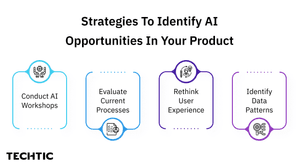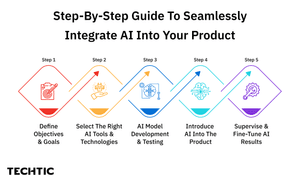Inculcating AI into Your Digital Product Seamlessly
Sector: Digital Product
Author: Nisarg Mehta
Date Published: 07/11/2024

Contents
The AI adoption rate across the world has increased to 35% which represents a 4% increase from the previous year. More specifically, 44% of businesses are building AI into the existing applications and systems. This surge points to the rise in the adoption of AI and the applicability of this technology across different fields.
The benefits realized are cost savings and efficiencies (54%), followed by improved IT or network performance (53%), and better customer experience (48%). Nevertheless, certain obstacles persist to a considerable extent: Lack of needed skills in AI (34%), high costs (29%), and the complexity of the projects that require implementation (24%) hinder AI adoption efforts.
These data points highlight the importance of a proactive or, at the very least, a well-planned approach to the integration of AI technologies.
What is Generative AI?
AI is the implementation of human factors in computers and machines that functions nearly like human brains. AI technologies enable computers to perform Natural intelligence tasks such as; Speech recognition, Decision making capability, and Visual perception.
The application of AI is not restricted to a particular branch but is seeping into various sectors such as healthcare and finance and software as service. Of course, before turning to the possibilities of applying AI in relation to a digital product, fundamental knowledge of AI is mandatory to mention.
Examples of SaaS businesses Incorporating AI into their Existing SaaS Products
Several leading SaaS companies are already leveraging generative AI to enhance their products:
HubSpot
With AI integration, HubSpot helps users receive relevant content/ offers/proposals based on their use of the platform, resulting in the improvement of user experience.
Zoom
The platform uses AI to enhance video quality during calls and filter out irrelevant background noise to provide clearer business meetings.
DocuSign
DocuSign applies AI to accelerate the electronic transactions rate, checking the authenticity of the signatures, and improve the documents’ security.
Slack
For Slack, AI helps to increase productivity because the application has a built-in chatbot called Slackbot with an AI feature that can set up meetings and make other reminders.
Zendesk
Zendesk incorporates AI features to ensure that individualized solutions are offered and consequently, first level problems solved as quickly as possible freeing up the support team to tackle tougher problems.
Dropbox
The AI of Dropbox in its “Smart Sync” helps it to improve its search power and enhance its content organization towards being smart enough to prioritize good and easily accessible documents.
Oracle
The cloud security apps from Oracle utilize AI and machine learning to enable real-time threat detection and policy regulation while making security stronger. It does this by studying the behavior of the users and recognizing deviations from the established norms.
How to find the AI Opportunity in Your Product
The question of how to leverage AI for SaaS is a critical one as targeting the correct AI initiatives may create a completely different product with a solid competitive advantage. Here are some strategies to uncover these opportunities:

Conduct AI Workshops
When it comes to AI discovery within a product, workshops are the best choice to make. These workshops involve the cross-functional teams where the participants are encouraged to discuss and research possible uses of AI. This approach can mean that these workshops can be quite effective in discussing and identifying with the help of experts the fields that are most suitable for AI’s applicability.
Evaluate Current Processes
Map your existing work processes to find out major activities that could potentially be handled by automated means and/or AI. Identify various routine operations, heavy computations, and tasks that are capable of benefiting from AI decision making.
Rethink User Experience
Think about how AI benefits and enhances the users of the product. AI makes it possible to individualize the user interactions, make relevant recommendations, and facilitate or respond to customer inquiries, thus enhancing usability and delightful experience of using the product.
Identify Data Patterns
Apply data analytics to discover the patterns that will be needed when deploying artificial intelligence. When you identify users’ behavioral patterns and expectations, you can then design AI functions that will complement these desires and improve the level of satisfaction.
Identify Your Product’s AI Readiness
There are three important things to consider to prepare your SaaS platform for integrating AI:
Assess Your Technology Stack
Assess the capabilities of the current technology architecture to identify whether AI can be integrated into its existing technologies. Check that your servers, databases, and software applications are ready to handle enhanced demands in volumes created by Artificial Intelligence.
AI Skills for Your Employees
At least in the recent past, AI technology wasn’t a job skill needed for every department. So, your existing workforce has to be trained in order to excel in the given field. You should provide your employees with the necessary training to acquaint themselves with current AI advancements, systems, platforms, and methods. This will enable them to learn some of the things that require to be done in order to implement and manage AI features.
Address Common Barriers
- Limited AI Skills and Expertise: 34% of businesses are struggling to overcome AI issues because of the shortage of AI specialists. Counter this by employing highly qualified personnel or collaborating with experts in the field of Artificial Intelligence.
- High Implementation Costs: Another disadvantage of using AI is that it can be costly to deploy. Think about the opportunities and return on investment when deciding to make a long-term investment. Opt for affordable AI solutions that will suit your pocket.
- Complexity of Projects: AI projects may be intricate and, therefore, difficult to implement. Here, the need for AI software development companies arises. They make it possible by dividing the integration process into stages and conducting adequate testing at each stage of integration.
- Data Complexity: When it comes to big data management, 24% of organizations reported that it was difficult. Adopt sound data management practices and technology to ensure the complexity of data is well managed.
Ensure Trustworthy AI
Both trust and responsibility are important to decision making and, therefore, essential to AI. Take the following steps to ensure your AI is reliable:
- Reduce Bias: Despite this awareness, only 26% of organizations have made efforts to combat bias in AI models, while a shocking 74% have not done so. Employ best practices to incorporate bias-free characteristics of artificial intelligence decision-making processes.
- Track Performance Variations: To ensure all the AI models are in place and stable, the performance should be monitored to detect any drifts or substandard outputs.
- Explain AI-Powered Decisions: Ensure that any action triggered by AI is traceable . This can reduce the tension users have when using it especially in decision making aspects – it makes them see the process through which the AI arrived at a particular conclusion.
How to successfully implement AI into SaaS.
Adopting AI in SaaS products can strengthen it and offer superior experiences to the users in different aspects. Here’s a step-by-step guide to seamlessly integrate AI into your product:

Step 1: Define objectives and goals
Be very specific when explaining what you want to get out of artificial intelligence. Establish an objective that is Specific, Measurable, Attainable, Relevant, and Time-bound (SMART). This also assists in referencing the integration of AI to your existing business strategy.
Step 2: Select the Right AI Tools and Technologies
Choose AI tools and technologies that are relevant for your product. Primary aspects that should be considered include flexibility, compatibility, and AI functionality required as per your need.
Step 3: AI Model Development and Testing
Develop and train models that are specific to your product. Train these models using your data so that they are as precise as possible. Carry out further tests to ascertain the efficacy of these models under different conditions.
Step 4: Introduce AI into the Product
Integrate AI features into your current product design. Make sure the integration works as expected and does not alter the existing features of your product. It is crucial to plan with your development team to confirm that integration is tightly integrated.
Step 5: Supervise and Fine-tune AI Results
Make sure to keep track of the performance of these AI models on a consistent basis. Take feedback and data collected and evaluate in order to make modifications required. Scheduling periodic optimization helps to maintain that the AI features stay useful and do not deteriorate into unhelpful gimmicks.
Final Note
The integration of AI within SaaS offerings is now becoming the key differentiator for companies. Incorporating AI into a product is possible if you follow the right approach, tools and strategies that make a product ready for a future challenge.



